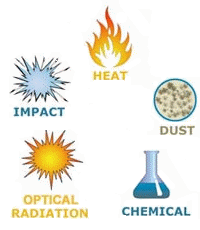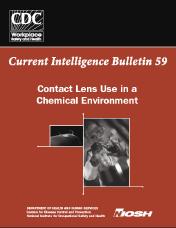Head and Foot Protection
- ANSI Z87.1 – 2003, American National Standard for Occupational and Educational Personal Eye and Face Protection Devices
- Head and Foot Protection Chart

Other Resources:

- Assessing the Need for Personal Protective Equipment: A Guide for Small Business Employers, OSHA Publication 3151-12R 2003
- Eye and Face Protection: Selecting PPE for the Workplace, OSHA e-Tool (Selecting Appropriate PPE for the Hazard)
- Recommendations for Chemical Protective Clothing, (A Companion to the NIOSH Pocket Guide to Chemical Hazards)
- OSHA Fact Sheet on Personal Protective Equipment

- OSHA Personal Protection Equipment Training Course
- Relevant OSHA Standards:
- Personal Protective Equipment for General Industry
- Eye and Face Protection, OSHA 1910.133
- Respiratory Protection, OSHA 1910.134
- Head Protection, OSHA 1910.135
- Occupational Foot Protection, OSHA 1910.136
- Hand Protection, OSHA 1910.138
Policy on Eye Protection

The UWM policy on eye protection is the same as the State of Wisconsin policy on eye protection as defined by Wisconsin Department of Safety and Professional Services regulations SPS 332 Public Employee Safety and Health.
Specifically, SPS 332.15 adopts the OSHA standard for eye protection. The standard is entitled: Eye and Face Protection, 29 CFR 1910.133, and is a subpart of the regulations entitled Personal Protective Equipment. The standard itself is very brief. It is the interpretation of the standard that is most difficult.
Synopsis of OSHA Eye and Face Protection (29 CFR 1910.133):
General Requirements
- The employer shall ensure that each affected employee uses appropriate eye or face protection when exposed to eye or face hazards from flying particles, molten metal, liquid chemicals, acids or caustic liquids, chemical gases or vapors, or potentially injurious light radiation.
- The employer shall ensure that each affected employee uses eye protection that provides side protection when there is a hazard from flying objects. Detachable side protectors (e.g. clip-on or slide-on side shields) meeting the pertinent requirements of this section are acceptable.
- The employer shall ensure that each affected employee who wears prescription lenses while engaged in operations that involve eye hazards wears eye protection that incorporates the prescription in its design, or wears eye protection that can be worn over the prescription lenses without disturbing the proper position of the prescription lenses or the protective lenses.
- Eye and face PPE shall be distinctly marked to facilitate identification of the manufacturer.
- The employer shall ensure that each affected employee uses equipment with filter lenses that have a shade number appropriate for the work being performed for protection from injurious light radiation.
Laboratories and Studios:
Many governmental agencies and standards organizations have issued interpretations of this standard and the one that is followed by UWM’s Department of University Safety and Assurances is the interpretation offered by the American Chemical Society in their publication, Safety in Academic Chemistry Laboratories (ISBN 0-8412-3864-2).
The ACS states that “…the use of proper eye protection is required of everyone who enters a chemical work area. There is always a need for protection from splashes of toxic and/or corrosive chemicals and flying particles. Safety goggles that protect the top, bottom, front and sides of the eyes are mandatory. Neither spectacles with side shields nor safety glasses with side shields provide adequate protection from chemical splashes, because they do not fit firmly against the skin.”
The OSHA Laboratory Safety Standard, a performance-based standard, requires that a “hazard assessment” be performed if there is to be any deviation from the “default” rules.
There are, therefore, two options available to laboratory directors:
- Laboratory directors may choose to stick with the default rule by requiring all employees to wear eye protection whenever in the laboratory. There are hundreds of styles of safety eyewear on the market today, so finding a comfortable pair of goggles or other approved safety eyewear for employees and students should not be a problem.or,
- Laboratory directors may prepare and use a Laboratory Specific Chemical Hygiene Plan (CHP; as defined by OSHA/COMM) for each lab. As this is a nationally accepted and legally binding protocol, lab directors are inclined to accept the use of well-developed CHP’s in lieu of “one size fits all” plans.
When a Laboratory Specific Chemical Hygiene Plan is developed, the workers in each lab have an opportunity to develop customized safety procedures that make the most sense for their operations.
If they want to undertake certain procedures that require goggles, certain procedures that require safety glasses, or certain procedures or even areas of the lab where eyewear is optional, they can do this through the Chemical Hygiene Plan development process. Be aware, however, that the Chemical Hygiene Plan development process is not trivial.
Prescription Safety Glasses:
The State of Wisconsin has a mandatory contract for prescription safety glasses for all State of Wisconsin agencies. To initiate the process to receive prescription safety glasses, the employee’s supervisor must contact safety-office@uwm.edu to request the prescription safety glasses form. The supervisor should include the name of the employee needing glasses on the request. The authorization for ordering prescription safety glasses form can then be picked up at Engelmann Hall, Room 270. Employees must then take this form to one of the providers found at https://www.hi-techoptical.com/partners/wida/.
Face Shields:
Face shields alone are not considered adequate eye protection. Face shields do not protect from splashes or impact hazards as well as goggles or protective spectacles. Safety goggles or glasses shall be worn as primary protection with face shields as secondary protection for further head protection. The face shield should be wide enough and long enough to protect the face, neck, and ears of the wearer.
Other Resources:
- Eye and Face Protection Standard, OSHA 1910.133
- Eye and Face Protection e-Tool, OSHA
- Eye and Face Protection Selection — Selection PPE for the Workplace, OSHA
- Guidelines For The Use of Contact Lenses in Industrial Environments, American Optometric Association
- Contact Lens Use in a Chemical Environment
 , NIOSH Current Intelligence Bulletin
, NIOSH Current Intelligence Bulletin - OSHA PPE Fact Sheet

- Fact Sheet on Eye Protection in the Workplace, U.S. Department of Labor
Personal Protective Equipment: Gloves
General Information
Some of the hazards that threaten hand safety are skin absorption of harmful substances, chemical hazards, such as caustic material, solvents or cutting oils, cuts or lacerations; punctures; chemical burns; thermal burns; harmful temperature extremes; bacteriological, blood or other infectious materials; and musculoskeletal disorders.
Preventing Hand Injuries

When substitution of less hazardous materials and work practice controls fails to eliminate the risk of injury to hands, protective gloves are the primary means of protection.
Protective equipment includes gloves, hand pads, tapes and mitts. There are many types of gloves available and the challenge is to find the right glove for the job. The glove on the right illustrates what can happen when a particular chemical is incompatible with the glove being worn.
- Chemical Resistant Gloves:
- Butyl: High resistance to gas or water vapors. Also resists common acids and alcohols.
- Hot-Mill or Aluminized Gloves: Offer reflective and insulating protection. Generally used for welding, furnace and foundry work.
- Latex: Provide protection from most aqueous solutions of acids, alkalis, salts and ketones. They resist abrasions during grinding, sandblasting and polishing. These general-purpose gloves are pliable and comfortable. Used for common industrial applications, food processing, maintenance, construction and lab work.
- Natural Rubber: Liquid proof protection against acids, caustics and dye stuffs.
- Neoprene: Provides protection against hydraulic fluids, gasoline, alcohols, organic acids and alkalis. They offer good pliability and finger dexterity, high density, tensive strength plus high tear resistance.
- Neoprene Latex: Protection against detergents, salts, acids and caustic solutions.
- Nitrile/Natural Rubber: Provide protection from chlorinated solvents and are intended for jobs requiring dexterity and sensitivity. Nitrile/Rubber blend resists abrasions, cuts, tears and punctures.
- N-DEX Gloves: This nitrile glove provides splash and spill protection against a wide variety of chemicals, although it is not intended for extended immersion activities. It is available in low-power and powder-free options.
- Polyvinyl Alcohol (PVA) Gloves: Resist strong solvents such as chlorinated and aromatic solvents. This material is water soluble (polyvinyl alcohol) and cannot be used in water or water-based solutions.
- Polyvinyl Chloride (PVC) Gloves: Good for handling materials coated or immersed in grease, oil, acids or caustics. Resists abrasion. Can be purchased lined or unlined depending on dexterity requirements.
- Silver Shield Gloves: Protection against a wide range of solvents, acids and bases. This lightweight laminate is flexible, but not form-fitting, which affects user dexterity.
- Vinyl: Provides resistance to a variety or irritants.
- Viton: Provides resistance to PCBs, chlorinated and aromatic solvents, gas and water vapors. This glove material can be used in water-based solutions.
- Cotton or Canvas Gloves: General work gloves for parts handling, general maintenance. Provide abrasion resistance.
- Leather Gloves: Mild heat resistance and good abrasion resistance.
- Metal-Mesh, Kevlar, or Other Cut-Resistant Gloves: Protect against cuts and abrasions. Used for glass handling, metal fabrication, food processing applications, and handling other sharp tools or objects.
- Shock-Absorbing Gloves: Protect against repetitive pushing and pounding or extended contact and help lessen the effects of constant vibration.
When ordering gloves, be sure to order the proper size. Tight-fitting gloves can cause fatigue and be more vulnerable to tears. They can also cause increased perspiration. Loose-fitting gloves impair dexterity and are cumbersome and even hazardous around laboratory equipment. Rings with prongs and long fingernails can tear gloves made of thinner materials.
To select the proper glove when working with chemicals:
- Determine what chemical(s) will be handled. Review the Material Safety Data Sheet (MSDS)
- Consider the degree of dexterity, gripping ability and ruggedness needed for the tasks to be performed.
- Review the chemical compatibility chart to determine breakthrough performance to determine the suitability of a glove for a specific application.
Visually inspect gloves each time they are worn and change them if they are cracked, peeling, torn, punctured or otherwise deteriorating. If there is any doubt about the integrity of the glove material, it should be discarded. Gloves can be leak-tested for defects difficult to see with the naked eye by trapping air in the glove, immersing it in a soap solution and squeezing it to pressurize.
Perspiration inside gloves softens the skin, making it more vulnerable to chemicals. This can be minimized by limiting the time gloves are worn (whenever possible), alternating pairs or using thin cotton gloves as replaceable inner liners. Some glove users experience a rash or an allergic reaction from the powdered coating inside certain gloves. Switching to a non-powdered glove should eliminate most of these problems. If irritation or rashes appear, try another type of glove.
Glove Compatibility Charts:
- Microflex Chemical Resistance Guide
- VWR Safety Glove Selection Guide
- Best Glove Chemrest Chemical Guide
- Saf-T-Guard Nitrile Gloves — Chemical Performance Data
- SpecWare Chemical Application & Recommendation Guide
- Mapa Professional Chemical Resistance Guide
- Super Glove
- MCR Safety Training Permeation Guide
Other Resources:
- NIOSH Safety & Health Topic Page: Occupational Latex Allergies
- NIOSH Publication: Latex Allergy: A Prevention Guide
- “Selecting Chemical Resistant Lab Gloves”, Lab Safety Review, January, 2000
- “Pros and Cons of Lab Glove Materials”, Lab Safety Review, January, 2000
Hazard Assessments for Personal Protective Equipment
A critical first step in developing a comprehensive safety and health program is to identify physical and health hazards in the workplace. This process is known as a “hazard assessment.” Potential hazards may be physical or health-related and a comprehensive hazard assessment should identify hazards in both categories.
The hazard assessment involves obtaining information on the types of hazards present, the toxicity of the materials involved, and what other options are available to control exposure. General information about chemicals may be found in Material Safety Data Sheets. The chronic and acute effect of chemicals, biological and radiological materials should also be assessed.
Examples of physical hazards include moving objects, fluctuating temperatures, high intensity lighting, rolling or pinching objects, electrical connections and sharp edges.
Examples of health hazards include overexposure to harmful dusts, chemicals or radiation.
Serious consideration should be given to reducing these hazards by the use of engineering controls and/or administrative controls. Personal protective equipment should be used in conjunction with engineering and administrative controls.
The hazard assessment should begin with a walk-through survey of the facility to develop a list of potential hazards in the following basic hazard categories:
- Impact: (Examples: Working with or around powered tools or machinery. Use of powered liquid sprayers, air hammers, compressed air, or working in areas with high air turbulence where particles, fragments or chips are present. Working in areas where overhead hazards, falling hazards or moving hazards are present.)
- Penetration: (Examples: Working with or around powered tools or equipment. Working with glass, wire, metal, sharp objects or other materials that can cut or pierce when broken or fragmented.)
- Compression — Pinching/Crushing/Roll-Over: (Examples: Working with or around moving equipment, or parts. Exposure to falling objects. Use of heavy equipment or tools that could cause compression injuries, etc.)
- Chemical: This is a broad category which may include chemicals ranging from slightly irritating (such as cleaning products) to highly corrosive or toxic substances used in laboratories or industrial settings. Working with carcinogens, mutagens or teratogens.
- Thermal — Heat/Cold: (Examples: Operating furnaces, pouring and casting hot metal, welding. Working on steam, refrigerant, high temperature systems, etc. Working with cryogenic materials. Working in temperature extremes (e.g., steam tunnels, freezers, extended work outdoors in winter, etc.)
- Harmful Dust (Examples: asbestos, fiberglass, silica, animal dander. Woodworking, buffing, and general dusty conditions. High levels of airborne contaminants that cannot be eliminated by engineering controls.)
- Light (Optical) Radiation: (Examples: Electric arc or gas welding, cutting, or torch brazing or soldering. Working with or around lasers. Working around sources of UV radiation.
- Biologic: (Examples: Working with human pathogens or materials that may be contaminated with infectious human pathogens.)
Each of the basic hazards should be reviewed and a determination made as to the type, level of risk, and seriousness of potential injury. Consideration should be given to the possibility of exposure to several hazards at once.
The workplace should be periodically reassessed for any changes in conditions, equipment or operating procedures that could affect occupational hazards. This periodic reassessment should also include a review of injury and illness records to spot any trends or areas of concern and taking appropriate corrective action.
The suitability of existing PPE, including an evaluation of its condition and age, should be included in the reassessment.
A copy of the completed Hazard Assessment Survey and Anaylsis should be sent to US&A for review. If you need assistance in conducting your hazard assessment, please contact US&A at x5808.
Other Resources:
Protective Footwear
Determining if Foot Protection is Necessary or Required

The initial step for assessing the need of personal protective equipment (PPE) is a hazard assessment. The assessment is an important element of a PPE program because it produces the information needed to select the appropriate PPE for any hazards present or likely to be present at particular workplaces.
For example, protective footwear must be worn when there is the hazard of:
- Falling or rolling objects
- Punctures
- Stubbing or banging
- Chemical or corrosive contact
- Electrical shock
- Burns
- Slips and falls
What’s Involved in Performing a Hazard Assessment?
Since this is a performance-oriented standard, employers must act in a reasonably prudent manner in determining when and how employees, who are exposed to foot injury hazards, are to be protected. In one recent decision, a Federal Appellate Court held that one employer who required its employees to wear sturdy work shoes and made steel-toed footwear available to these employees at a discount, was acting reasonably. A policy requiring steel-toed shoes was found not necessary despite the presence of some foot hazards. OSHA believes that what is reasonably prudent with regard to foot protection may depend on:
- the frequency of the employees’ exposure to foot injury,
- the employer’s accident experience,
- the severity of any potential injury that could occur, and
- the customary practice in the industry.
Determining Type of Footwear
Select protective footwear based on the hazard assessment. For example:
- Steel-toed shoes to resist impact
- Metatarsal guards to resist impact above the toes
- Reinforced flexible metal soles or inner shoes to protect against punctures (assuming there’s no risk of electrical contact)
- Sandals and open-toed shoes are prohibited in laboratories (including art studios), and food service areas (for safety and hygienic reasons)
- For falling objects, use footwear with steel toes.
- Use metatarsal guards if there is the hazard to the metatarsal region above the toes.
- Wear chemical resistant footwear (e.g., rubber, neoprene) in areas with potential chemical or corrosive splashes. Check the MSDS to match footwear with individual chemicals.
- Replace worn footwear.
Even if protective footwear is not deemed necessary, employees should still wear sturdy shoes with nonskid soles. Sandals, sneakers or dress shoes may not be appropriate for many physical activities.
Frequently Asked Questions Regarding Protective Footwear:
- Is there a specific OSHA law in regard to foot protection? Actually several OSHA standards establish rules and guidance. OSHA’s Occupational Foot Protection Standard, 29 CFR 1910.136, requires that employees wear protective footwear when exposed to dangers from falling objects, objects piercing the sole, or electrical hazards. The OSHA Personal Protective Equipment (PPE) Standard also requires that supervisors conduct a hazard assessment, develop a written plan, enforce policies, and train employees in foot protection concepts.
- What are the performance standards for protective footwear? As a minimum standard of protection, all safety footwear must meet the general requirements for impact and compression resistance, as required by ASTM F2413 (or ANSI Z41, Class 75, for footwear purchased prior to March 2005).
- What if an employee shows up at work and has forgotten his/her protective footwear? The employer is not obligated to provide employment if the employee fails to act in a reasonable and safe manner. So, if the employee is not prepared for work (i.e., lacking proper footwear), they do not need to be given work. In fact, assigning a task which requires foot protection when a worker doesn’t have the right shoes would be considered negligent.
- I’ve been told by my supervisor I must wear protective footwear because of my job. Can I be disciplined for not wearing it? Yes.
- Is the wearing of foot protection the employer’s or employee’s responsibility? Technically, the burden is the employer’s responsibility. For example, the employer is responsible for conducting the hazard assessment, the selection of PPE, determining the limitations of PPE, training, and ensuring the employee does what is required (i.e., enforcement). However, the employee must also assume responsibility to act in safe and healthful manner.
- Is employee training required for occupational foot protection? Yes. Once it has been determined that PPE is required, employees must be trained in the proper use and limitations of the equipment. For example:
- When PPE is necessary
- What PPE to use for particular hazards
- Limitations of PPE
- How to put on, adjust, wear, and remove PPE properly
- Care and maintenance of PPE.
Training needs to be sufficient to cover these five points. This can be covered in New Employee Orientation, or during on-the-job training.
- Who pays for the foot protection?The employer is not required to provide PPE of a personal nature (e.g., uniforms, work gloves, footwear, etc.), for the employee. However, the employer is required to ensure that protective footwear is worn if the hazard assessment determined that such PPE is necessary. The employer may specify the type of PPE to be worn or, for that matter, prohibit what should not be worn (e.g., no bare feet, sandals, open toed shoes).
The employer (UWM) does need to provide specialized PPE, such as welding helmets and chaps, respirators, hearing protection, etc. The test is whether the PPE would normally be worn outside of the workplace as well as in the workplace. If yes, the worker may be required to buy, or the employer may supply. If no, the employer must supply the necessary PPE. - Is foot protection (e.g., steel-toed shoes) required for employees working, for example, on loading docks?There isn’t a simple “yes” or “no” response. A reasonable answer would probably be: “It depends on the circumstances and the likely hazards.”
- I’ve heard that steel-toed shoes may actually increase the extent of injury should a heavy object crush the shoe. Is this correct? Steel-toed shoes are very effective in preventing injury to the toes as is so common in the workplace. All PPE, including protective footwear, has limitations. Severe injury hazards as you described should be eliminated using engineering controls, not by the mere use of PPE.
- Have we had any foot injuries at UWM due to lack of protective footwear? Yes. In one instance, a research assistant had two toes amputated when an I-beam fell from its support. The beam was only one foot off of the floor. Protective footwear would have prevented this injury. Regardless, this hazard should have been identified and eliminated by “engineering” a better support for the beam.
- What kind of shoe should electricians wear? Shoes with non-conductive soles meeting the requirements of ANSI Z41 PT9l (M/F) I-75 C-75 EH. “EH” represents the “electrical hazard” designation.
- What kind of shoe protects against punctures? At a minimum, a sturdy work shoe must be worn where injury from puncture is likely. Boots with steel insole: ANSI Z41 P91 (M/F) I-75 C-75 PR “PR” is the “puncture resistant” designation.
- What kind of shoe should be worn to prevent static buildup? ANSI Z41 P91 (M/F) I-75, C-75 SD Type I. “SD” is the “static discharge” designation.

